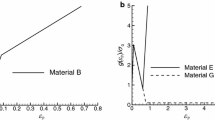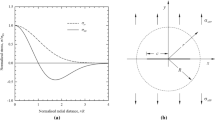Abstract
A penny-shaped crack in a material which is ideally elastic-plastic has been envisaged with the assumption that the plastic zone forms a very thin layer surrounding the crack. The Dugdale hypothesis has been adapted and thus the problem has been reduced to that of an elastic semi-space with properly modified boundary conditions. The entire energy absorbed in the process of creation of a new surface is associated with the work expanded in irreversible plastic deformation, the work of cohesive forces being neglected. The displacements of the crack surfaces are calculated as well as the plastic energy dissipation and the fracture criterion is discussed.
The shape of the crack, obtained here, differs considerably from that predicted by the theory of elasticity, particularly at the crack tip. The differences in the values of the critical pressure calculated from the Griffith-Sack-Sneddon formula and those obtained by use of the equations derived here are also significant. It is shown that for macro-cracks when crack radius ℓ is not too small the following formula holds
which agrees with the Orowan-Irwin modification of Griffith's theory; (dWp/dA)crit denotes the plastic work per unit area of new surface, dissipated in the course of loading before fracture.
The results of this paper hold for the so called ‘quasi-brittle’ solids. Two schemes of loading are considered: 1. pressure applied on the crack surfaces and 2. applied at infinity. Attention is paid to a slightly different mechanism of fracture in both the cases.
Résumé
Une fissure de révolution dans un materiau parfaitement Elastique-Plastique fur envisagée sous P'hypothèse que la zone de déformation plastique constitue une très fine couche entourant la fissure. Par application de Phypothèse de DUGDALE, le problème fut ramené à l'étude d'un espace élastique semi-infini présentant des conditions aux limites convenablement modifiees. La totalité de l'énergie absorbee dans la formation d'une nouvelle surface est associée avec le travail mis en jeu dens le deformations plastiques irréversibles, le travail des forces de cohésion étant néglige. Les déplacements des surfaces de fracture sont calculés l'énergie dissipée par déformation plastique et le critere de rupture sont exposés.
La forme de la fissure, obtenue ici, est considerablement differente de celle prévue par la théorie de l'élasticite, en particulier à l'extremité de celle-ci. Les différences dans les valeurs des pressions critiques, calculées à partir de la formule de GRIFFITH-SACK-SNEDDON, et obtenues à Paide des équations presentees ici, ont une certaine importance. On démontre que pour des ‘Macro -Fissures’ dont le rayon λ pèst pas trop petít la formule suivante est valable:
celle-cl est compatible avec la modification de la théorie de GRIFFITH, faite par OROWAN et IRWIN. La quantité (dWp/dA)crit correspond au travail dissipé dans une unité d'aire de la nouvelle surface par les déformations plastiques apparaissant au tours de la charge precedant la rupture.
Les resultats de cc memoire s'appliquent au cas des solides appelés ‘Presque-Cassant’. Deux types de charge sont considérés:
-
1°
pressíon appliquée sur les surfaces de rupture
-
2°
pression appliquée a Finfini. Une légère difference dans le mécanisme de la rupture est prise en consideration das les deux cas.
Zusammenfassung
Ein ebener, kreisförmigen Bruch in einem ideal elastisch-plastischen Material wurde unter der Annahme betrachtet, dass die plastische Zone nur eine sehr düne Schicht am Bruchumfang ist. Mit Hilfe der Dugdale Hypothese wurde das Problem auf das eines elastischen Halbraumes mit entsprechend ahgewandelten Grenzbedingungen reduziert. Die gesamte, bei der Bildung neuer Oberflache absorbierte Energie wind von der zur Herstellung der irreversiblen plastischen Verformungen erforderlichen Arbeit errechnet, die fur die Überwindung der Kohäsionskräfte benötigte Arbeit wird vemachlässigt. Die Verformungen der Bruchflächen und die Energiedissipation infolge der plastischen Verformungen werden berechnet and das Bruchkriterium wird diskutiert.
Die hier errechneten Verformungen der Bruchflachen sind wesentlich unterschiedlich von denen, die mit Hilfe der klassischen Elastizitätslehre gefunden werden, insbesondere in der Nähe der Bruchperipherie. Der Unterschied zwischen dem auf diesem Wege gefundenen Wert für den kritischen Druck und dem von der Griffith-Sack-Sneddon Formel gelieferten Wert ist ebenfalls beträchtlich. Es wird gezeigt, dass die folgende Formel
fur Makrobrüche, deren Bruchradius λ nicht zu klein ist, Gültigkeit besitzt; (dWp/dA)crit bezeichnet die plastische Arbeit pro Einheit neu geschaffener Oberfläche, die während der Belastung his zum Bruchpunkt dissipiert wird. Diese Formel stimmt mit der Orowan-Irwin Modifikation der Griffith Theorie überein.
Die Ergebnisse dieser Arbeit sind fur sogenannte ‘quasi-spröde’ Materialien gültig. Zwei unterschiedliche Belastungsvorgänge werden betrachtet: l. Druckkräfte wirken auf die Bruchoberflächen, 2. Druckkräfte werden im Unendlichen angewendet. Die Aufmerksamkeit ist auf geringfügig unterschiedliche Bruchmechanismen in den beiden Fällen gerichtet.
Similar content being viewed by others
References
D.N. de G. Allen, R.V. Southwell Phil. Trans. Roy. Soc. A, 242, 379 (1949).
G.I. Barenblatt Zhurnal Prikladnoj Mekhaniki i Tereoticheskoj Fiziki, 4, 3 (in Russian), (1961).
B.A. Bilby, A.H. Cottrell, K.H. Swinden Proc. Roy. Soc. A, 272, 304 (1960).
B.A. Bilby, A.H. Cottrell, E. Smith, K.H. Swinden Proc. Roy. Soc. A, 279, 1 (1964).
D.S. Dugdale J. Mech. Phys. Solids, 8, 100 (1960).
N.E. Frost, D.S. Dugdale J. Mech. Phys. Solids, 6, 92 (1958).
W.W. Gerberich Proc. SESA 2, 21, 335 (1964).
J.N. Goodier, F.A. Field Fracture of Solids, New York, 103 (1963).
I.S. Gradshtein, I.M. Ryzhik Tables of Integrals, Moscow (1962).
A.K. Head J. Appl. Mech. 23, 407 (1956).
J. Hult, F. McClintock IX Int. Congr. Appl. Mech., Brussels, Proc. VIII, 51, (1956).
G.R. Irwin Fracture Mechanics, Pergamon Press, (1960).
J.A. Jacobs Phil. Mag. 41, 349 (1950).
S.J. Yarema Voprosy Mekh. Realnogo Twerd. Tela 1, Izd.A.N.SSSR,Kiev, 177 (1964), (in Russian).
G.I. Kornilov, S.J. Yarema Voprosy Mekh. Realnogo Twerd. Tela 1, Izd. A.N. SSSR, Kiev, 29 (1962), (in Russian).
M.J. Leonov Zhurnal Prikladnoj Mekh. i Teoret. Fiziki 3, 85 (1961), (in Russian).
Z. Olesiak, M. Wnuk Bull. l'Acad. Pol. Sciences, Serie Techn. 13, 8 (1965); full text in Rozprawy Inzynierskie, 1 (1966) (in Polish).
E. Orowan Fatigue and Fracture of Metals, Wiley and Sons, 1952.
E. Orowan Welding Journal, 157 (March 1955).
K.N. Rusinko Voprosy Mekh. Rel. Twerd. Tela 2, Izd. A.N. SSSR, Kiev, 27 (1964). (in Russian).
I.N. Sneddon Fourier Transforms, McGraw-Hill (1951).
I.N. Sneddon Proc. Roy. Soc. A, 187, 229 (1946).
I.N. Sneddon Crack Problems in the Theory of Elasticity, Dept. Math. and Eng. Research, North Carolina State College, Raleigh (1961).
E. Smith Proc. Roy. Soc. A, 282, 422 (1964).
E. Smith Proc. Roy. Soc. A, 285, 46 (1965).
L.D. Stimpson, D.M. EatonARL-24, Aeron. Res. Lab., OAR, (1961).
J.L. Swedlow, W.W. Gerberich Proc. SESA 2, 21, 345 (1964).
P.M. Vitvitski, K.J. Leonov Voprosy Mekh. Real. Twerd. Tela 1, Izd. AN SSSR, Kiev, 13 (1962), (in Russian).
T. Yokobori Strength, Fracture and Fatigue of Materials, Noordhoff, Groningen (1965).
J.P. Zheltov, S.A. Khristianovich Izd. A.N. SSSR, OTN, nr 5 (1955), (in Russian).
Author information
Authors and Affiliations
Rights and permissions
About this article
Cite this article
Olesiak, Z., Wnuk, M. Plastic energy dissipation due to a penny-shaped crack. Int J Fract 4, 383–396 (1968). https://doi.org/10.1007/BF00186804
Received:
Revised:
Issue Date:
DOI: https://doi.org/10.1007/BF00186804




